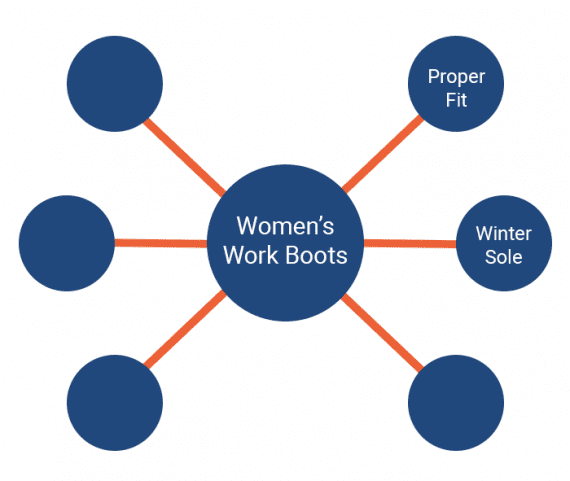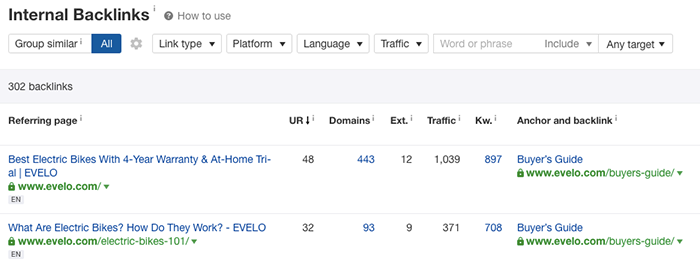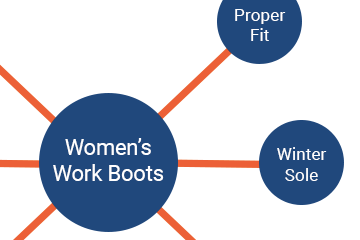An internal linking strategy around topic clusters or silos can improve site architecture, help search engines understand your content, and improve how important pages rank on a search engine results. But topic clusters are not a set-and-forget strategy. They require monitoring.
Topic clusters or silos are internal linking strategies to help a business organize the content (pages) on its website and, in the process, improve search engine optimization as well as making a site relatively easy to navigate and use.
In practice, a single pillar page serves as the topical hub for all related pages and articles.
Thus, an online retailer might have a topic around women’s work boots. A central women’s work boots page would serve as the pillar or hub page with other pages linking back to it.
Some of the pages that could link to a “women’s work boots” pillar page include an article about how to pick the proper size for a women’s work boot or a discussion of which boot soles are best for working outdoors.

The pillar page is the center of a hub (“Women’s Work Boots” in this example) with supporting articles or pages linking back to it.
Focusing links back to the pillar page signals to Googlebot and other search engine crawlers that it is the most important content on the topic and should receive the best ranking.
But how do you know if a topic cluster is working?
How to Monitor a Topic Cluster
Once you have selected topics for your company’s content marketing clusters and begun to create your content, start to monitor topic clusters to ensure they are sending the desired signals to search engines and that they remain consistent as new content is added.
Topic cluster KPIs. Start by establishing key performance indicators for your topic cluster strategy. While there could be some specific KPIs for a given pillar page — i.e., a lead collection page would measure leads, while an ecommerce product page might measure sales — many topic cluster strategies would feature the following four KPIs.
- Rank position. Monitor where the pillar page ranks in search results for keywords relevant to the topic cluster. The rank position should be measured over time to improve or maintain rank.
- Organic traffic volume. The purpose of SEO is to increase site traffic. So monitor organic traffic volume to the pillar page.
- Engagement. Compare several metrics such as bounce rate and time on page to determine if the pillar content is meeting visitors’ expectations.
- Conversions. This, again, might be generating a lead or making a sale. In any case, topic pillars should have a call-to-action and offer a conversion opportunity.
In addition to regularly monitoring these topic-cluster-related indicators, use tools such as Screaming Frog’s SEO Spider or Ahrefs to examine links.
SEO Spider Link Score. The premium version of Screaming Frog’s SEO Spider, which costs about $200 per year as of November 2019, includes a crawl analysis metric called Link Score.
This Link Score is similar to early versions of Google’s PageRank algorithm but focuses exclusively on internal linking. This focus can make it a useful tool for monitoring topic clusters.
The SEO Spider identifies “eligible URLs.” These are pages that have internal links. These internal links may be an anchor tag, a canonical tag, or the result of a redirect.
Eligible URLs are then ranked. “Link Score is passed between the URLs based on link relationships.” according to a post on the Screaming Frog website.

A topic cluster’s pillar page should achieve a high Link Score from the SEO Spider.
“Each eligible URL is considered in turn and has its Link Score updated. Every inbound link passes Link Score. It passes the Link Score of the originated URL, divided by the number of outbound links. The total Link Score from each inbound URL is then added up and used to set the URLs Link Score.”
The resulting Link Score is displayed on a logarithmic scale from 0 to 100. This simple tool will show you which pages on your site have the highest Link Score. For topic clusters, the aim is to move the pillar page’s score to 100.
Ahrefs Internal Backlinks report. Another tool that may help monitor topic clusters is Ahrefs’ Internal Backlinks report. It will show all of the internal pages that link to the particular topic cluster’s pillar page.

Ahrefs’ Internal Backlink report can display each page that links to a given pillar page.
For this tool to work for topic clusters, focus on the pillar page’s exact URL and view all results instead of allowing Ahrefs to group similar links.
The report shows the total number of internal backlinks to the pillar page along with a list of every referring page. Working through this list can identify opportunities to improve links or discover relevant pages that are not linking.







